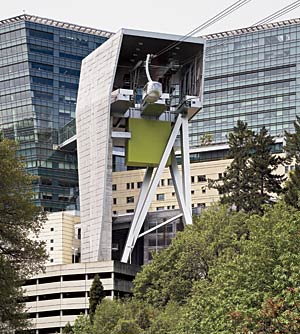 Posted Jan 7, 2008, 7:29 PM
Posted Jan 7, 2008, 7:29 PM
|
 |
Portage & Main 50 below
|
|
Join Date: Feb 2006
Location: Seattle
Posts: 4,871
|
|
Portland's system..
 
And FAQ from the Tram's webpage..
http://www.portlandtram.org/faq.htm
Quote:
FREQUENTLY ASKED QUESTIONS
How high, how far, how fast?
The Tram cabins travel 3,300 linear feet between the South Waterfront terminal adjacent to the OHSU Center for Health & Healing, and the upper terminal at the Kohler Pavilion on OHSU's main campus. Traveling at 22 miles per hour, the Tram cabins rise 500 feet for the three-minute trip over I-5, the Lair Hill neighborhood and the Southwest Terwilliger Parkway.
Why a Tram?
OHSU needs to expand beyond its Marquam Hill campus to meet increased patient, education and research needs. The underused properties of South Waterfront provided a location that would keep OHSU's growth in Portland. After years of discussion and study of options to connect the upper campus with the new area, the Portland City Council adopted the Marquam Hill Plan that included the Tram as the superior system over shuttles and other alternatives to link the two areas.
Who owns the Tram?
The Portland Aerial Tram is part of Portland's public transportation system, and is owned by the city. OHSU provided $40 million of the $57 million construction cost of the Tram. The city's share of construction costs ($8.5 million) will be collected over time from the rising property values in South Waterfront caused by its redevelopment. OHSU oversees operation of the Tram, while the city is responsible for the maintenance of the upper and lower stations and tower, and provides regulatory oversight.
Who designed the Tram and cabins?
The Tram was designed by Angelil/Graham/Pfenniger/Scholl, based in Zurich, Switzerland, and Los Angeles. The custom-designed cabins were made by Gangloff Cabins of Bern, Switzerland.
How safe is the Tram?
The Tram is exceptionally safe. Concerns about the seismic history of our region have been addressed in the Tram's design. It meets the new, more rigorous Swiss standards for aerial tramways and, thus, exceeds U.S. seismic standards. The Tram is equipped with redundant (backup) drivers and generators in the event of power outages, and the entire system is under constant computer monitoring.
Will weather affect the Tram?
There will be times when high winds or ice may affect Tram operations. However, this type of Tram has proved itself very capable and trustworthy in the extreme winter conditions of the Swiss Alps. Tram staff closely monitor weather conditions and will delay operations if needed.
Will the Tram cabins ever get delayed in mid-route?
Tram operators know from experience that Tram cabins will occasionally be stopped in mid-trip for a few seconds and - in rare instances - for several minutes while Tram operators make routine adjustments. If there is a delay, your Tram operator will explain the reason and advise on how long the delay will last.
|
__________________
WINNIPEG: Home of Canada's first skyscraper!
|